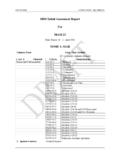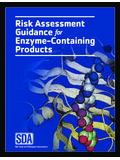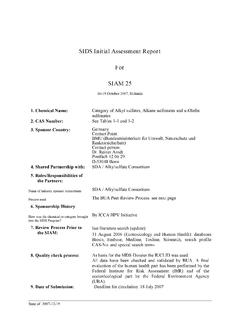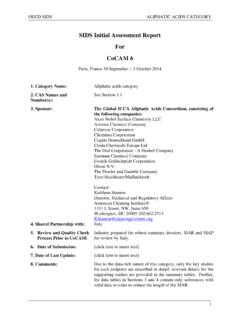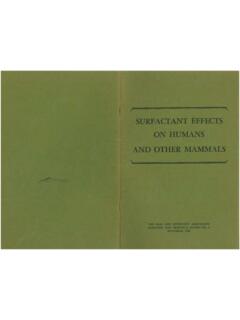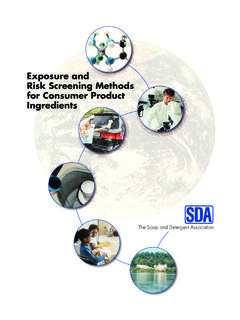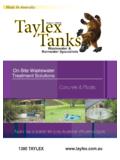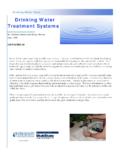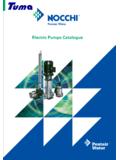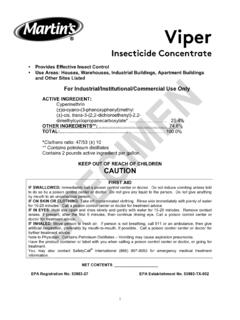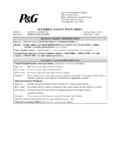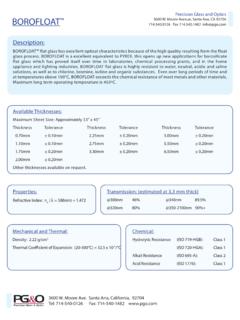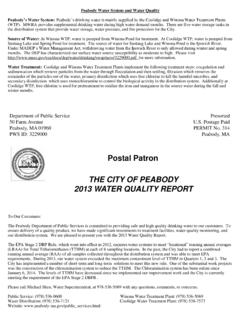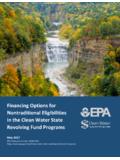Transcription of INTRODUCTION - Cleaning Institute
1 INTRODUCTION This monograph summarizes: 1) critical fate and effects data required for an environmental risk assessment on polycarboxylates; and 2) conclusions drawn from a risk assessment of polycarboxylates in the United States. Although focused on conditions in the , data from other parts of the world that are relevant to a assessment are included in the monograph. The monograph is written for a technical audience, but not necessarily one familiar with environmental risk assessment. The monograph is formatted into five sections. The first section describes polycarboxylates, their chemical structure and consumption volumes.
2 The second section describes the function of polycarboxylates in Cleaning products. The third section describes their fate and exposure concentrations in the environment. The fourth section presents environmental effects information. The fifth section presents a comparison of exposure and effects concentrations in the framework of an environmental risk assessment. The Soap and Detergent Association and its member companies do not make any warranties, expressed or implied, with respect to the accuracy or completeness of the information con- tained herein, and assume no responsibility or liability for the use of the information. Neither do The Soap and Detergent Association nor its member companies assume any responsibility to amend, revise or update information contained herein based on information which becomes available subsequent to publication.
3 O 1996 The Soap and Detergent Association This paper is made from 50% recycled fibers that include 10% post consumer waste. Chemical Description Polycarboxylates are anionic polymers with a carbon- carbon backbone and attached carboxyl functionality. Polycarboxylates are identified by the monomers used in their preparation and the molecular weights of the resultant polymers. The most commonly used polycarboxylates are sodium polyacrylate with average molecular weights (Mw) of 2,000-10,000, and sodium (acrylic acidfmaleic acid) copolymers with average Mw of 20,000-70,000a. These products are very water soluble and are typically supplied as 40-50% solutions (by weight), but dry powders are available.
4 The Chemical Abstracts Services (CAS) has assigned numerous registry numbers to polycarboxylates, of which 9003-04-7 (2-propanoic acid, sodium salt, homopolymer) and 52255-49-9 (2-propanoic acid, polymer with 2,5-furandione, sodium salt) are representative examples. Consumption The total end use of low molecular weight polycarboxylates in the in 1993 was estimated to be 165 million pounds (MM ) on an actives basis, of which 58 MM Ibs. were used in detergents and cleaners (Goin, Somogyi, Janshekar and Ishikawa, 1995). Other applications are as dispersants in water treatment; in pigment sluny production (clays, titanium dioxide, calcium carbonate); in water-soluble paints; and in textile and leather processing.
5 Sodium polyacrylate Sodium (acrylic acid/maleic acid) copolymer Polycarboxylates are added to Cleaning products as production aids, performance enhancers, builder assists, antiredeposition agents, and for particle property improvement. These polymers can be used in home laundry detergents, automatic dishwashing detergents, industrial and institutional Cleaning formulations, bar soaps and hard surface cleaners. Household powder laundry detergents are the major end use in the and can con- tain polycarboxylates in the range of , depending on the:formulation and intended function of the polymer. a Polymeric products contain molecules'having many different chain lengths.
6 Since a dis- tribution of molecular weights (MW) exists in any sample of polymer. the experimental measurement of Mw can only give an average value. These reported values represent the weight-avwge molearlar weight based on tk dishibtion h each molecule's mas. For a rmre dehiled discussion of polymer Mw distributions, see. for example, Billmeyer. 1962. The key performance properties of polycarboxylates are as a dispersant for soils (for removal and prevention of soil redeposition), and in crystal growth inhibition to prevent incrustation of inorganic salts onto fabrics (especially in non-phosphate laundry detergent powders).
7 If polycarboxylates are not present in a detergent (and particularly a non-phosphate powder), particulate soil Cleaning efficiency may be, diminished and graying or harshness of the washed fabrics may occur. Additionally, detergent processing could be adversely affected and particle integrity could be decreased. ENVIRONMENTAL FATE AND EXPOSURE Fate The major source of the polycarboxylates likely to be released to surface waters is Cleaning products used in the home. The other applications for low molecular weight polycarboxylates are highly unlikely to result in surface water discharge or release of the polymer to the aquatic environment.
8 It is reasonable then to consider only polycarboxylates used in consumer Cleaning products. Therefore, the most probable route of environmental exposure is as a result of laundry detergent use and discharge of the wash water to municipal or on-site waste treatment systems. Use of other Cleaning products would also lead to discharge to waste treatment systems and, in some cases, landfills as a result of wiping surfaces with cloths or paper towels. Release of polycarboxylates to surface waters from pigment slurries is not as likely, since the polycarboxylate is strongly bound to the pigment. If discharges are made from water treatment applications, they would be more site specific but could include both direct discharges to natural waters as well as discharges to treatment facilities.
9 Biodegradation Biodegradation of polycarboxylates is dependent on the molecular weight of the polymer, with increasing molecular weight resulting in decreasing degradation (Freeman, Paik, Swift, Wilczynski, Wolk and Yocum, 1996). In general, polycarboxylates used in Cleaning applications are higher in molecular weight than the polymers found to degrade. A polyacrylate with a Mw of 4,500 is mineralized to only 15% at environmentally realistic test levels (1 mg/L) as measured by C02 evolution (Freeman and Bender, 1993). This degradation presumably arises from the lower molecular weight fraction of a polymer's molecular weight distribution.
10 Biodegradation of a 70,000 Mw copolymer has been reported to be 6-20%, depending on the test conditions (Chiaudani and Poltronieri, 1990) which, as in the case of the polyacrylate, arise from the low POLYCARBOXYLATES L1 molecular weight fraction of the polymer. Table 1 summarizes the biodegradation test data for both polycarboxylates. Stability Polycarboxylates are generally stable to both chemical degradation and photodegradation, and especially so under environmental conditions. Hypochlorite can cause degradation of some polycarboxylates depending on the method of their preparation. This degradation appears to be significant only under extreme conditions not found in typical applications, and follows a chain scission mechanism which only partly breaks down the polymer (Jones, 1993).
